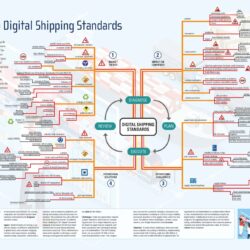Mindmap Digital Shipping Standards

The container shipping industry is rapidly evolving, and stakeholders must embrace digitalization to remain competitive. The Digital Container Shipping Association (DCSA) and Supply Chain Movement have collaborated to create a practical and concise mindmap that outlines the potential benefits of digital trade and shipping. With clear indicators of potential risks, this tool can help stakeholders navigate the digital landscape and improve the customer journey of goods.
Mindmap manual
Market trends – The world is facing unprecedented challenges with rapidly aging populations, economic slowdown, changing consumer behavior, emerging technologies like ChatGPT, climate change, and geopolitical unrest. These factors are affecting global trade, with more cross-border trade and a trend towards nearshoring to Mexico and onshoring to Western Europe. Inflation is also leading to increased costs of trade. As a result, companies are forced to analyze their business environment and diagnose potential issues.
Impact – Market trends are having a significant impact on different stakeholders in global trade and container shipping. Carriers and cargo owners, including manufacturing companies, wholesalers, retailers, and e-commerce platforms, are facing increasing costs and pressure on margins. The pandemic has also affected the trade financing market. To address these challenges, the Digital Container Shipping Association (DCSA) has been founded and several digital platforms have been launched. These stakeholders must work together to develop a sound strategy to navigate the market trends and plan for the future.
Challenges – Trade documentation remains a paper-intensive and resource-consuming process. For a single shipment, up to 50 sheets of paper may be required, and these documents are exchanged among up to 30 stakeholders. The bill of lading alone can account for 10-30% of total trade documentation costs. Port congestion can also be caused by missing or incorrect container documents, resulting in a lack of cargo visibility, increased inventory in the supply chain, and even lost sales. To address these challenges, carriers, cargo owners, and freight forwarders must execute.
Solutions – To solve these challenges, there are solutions available. According to McKinsey, implementing an electronic bill of lading could save $6.5 billion in direct costs and enable $40 billion in global trade. It’s important for all stakeholders to continue their efforts in data standardization and set ambitious targets for digitalization. Collaboration is key to accelerate the progress. By applying digital standards for the bill of lading, stakeholders can improve the customer journey of goods and unlock their potential value. It’s time to review these solutions.
Find more mindmaps of Supply Chain Movement here >>










